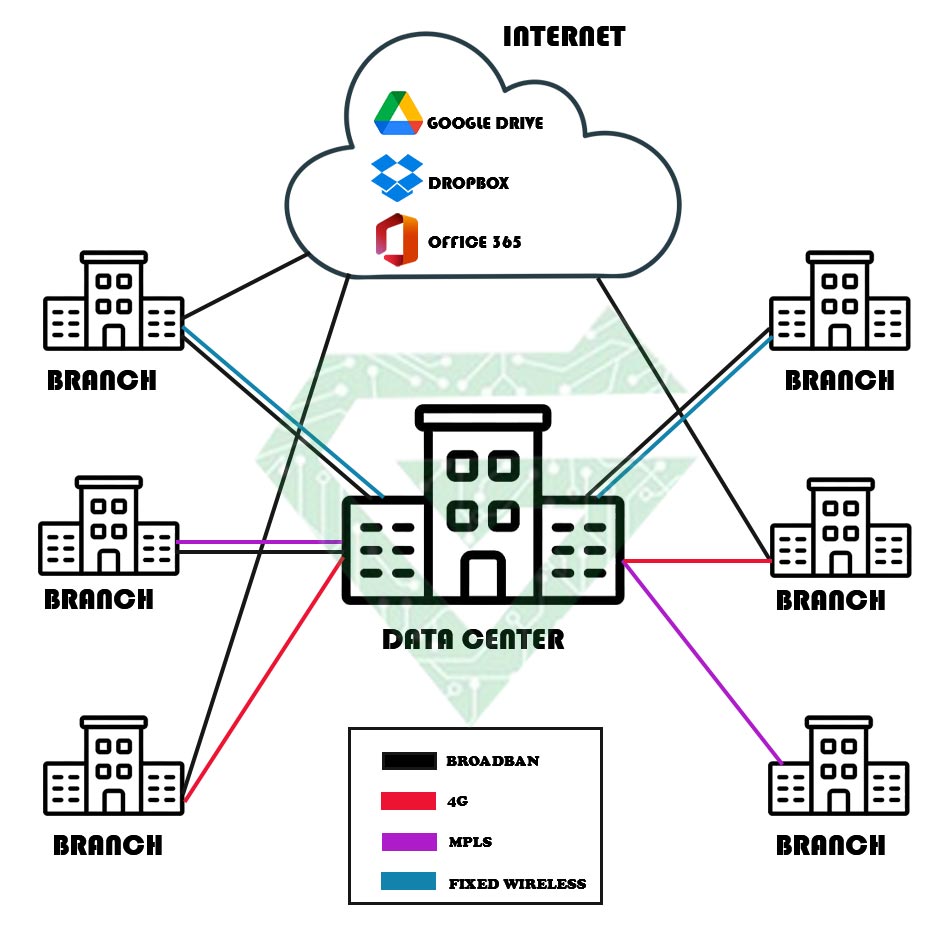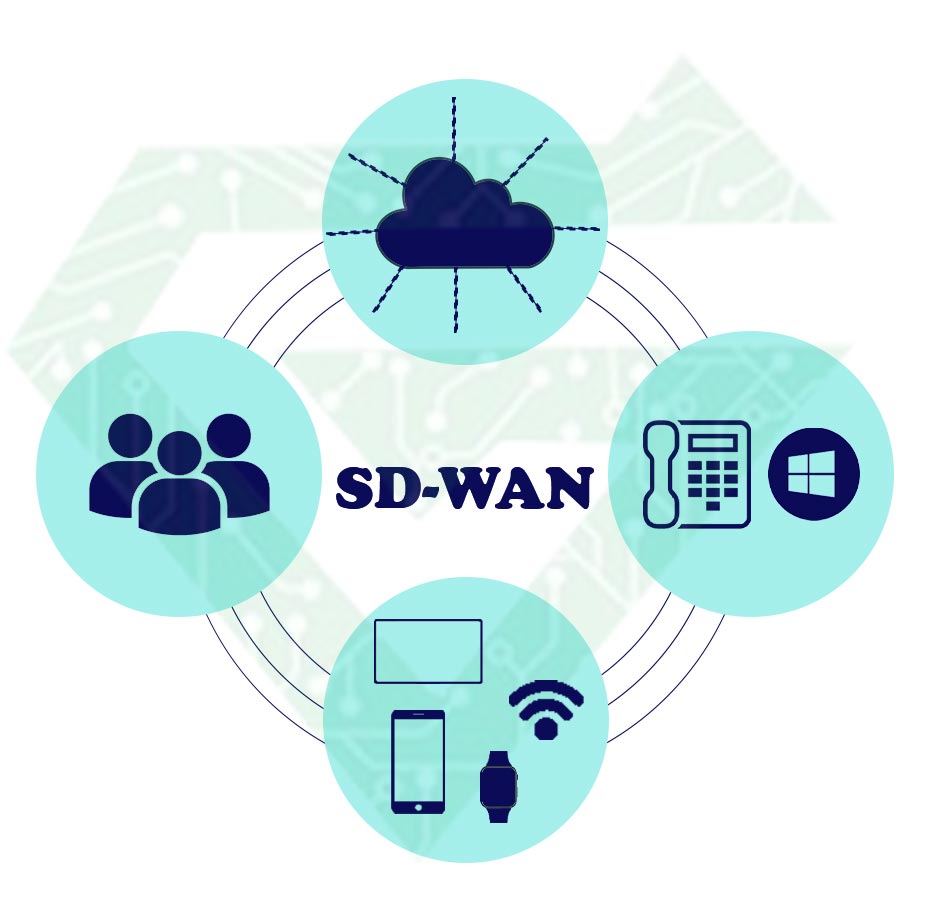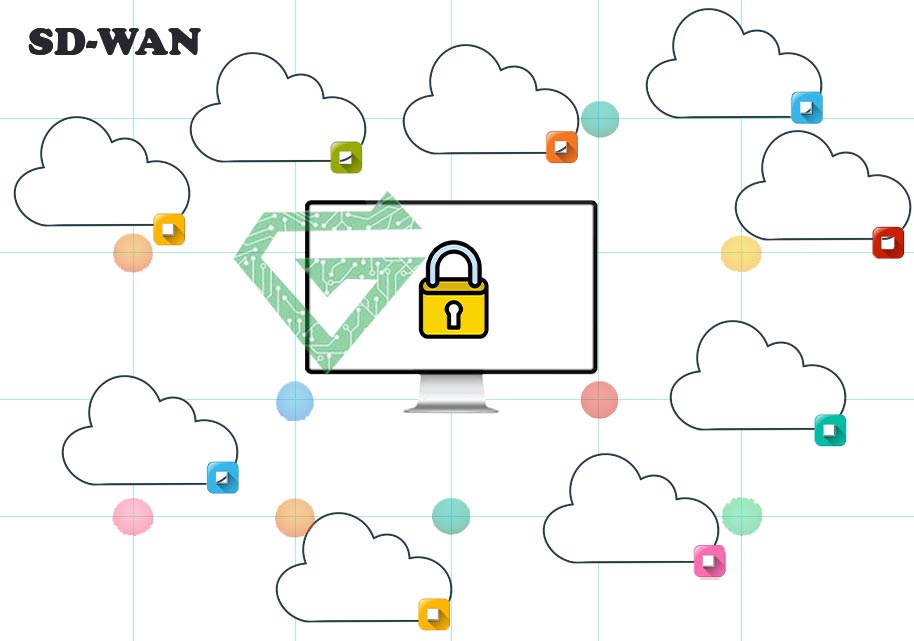What is SD-WAN protocol and how does it work

There are a lot of software that help to the network manager for increasing the operation of network and making the office and organization secure. This ability makes the users be able to connect data and information in different locations.
SD-WAN is a protocol that use in network equipment such as network switch, server, network router and etc. All companies are trying to design their products that compatible with these protocols and abilities, so we will explain to you about SD-WAN and how does it work in this article.
What is SD-WAN protocol?
SD-WAN (Software-Defined Wide Area Network) is a modern approach to design and manage wide-area networks (WANs). It uses software to control the connectivity, management and optimization of a WAN, allowing businesses to securely connect geographically dispersed locations over the internet.
Unlike traditional WAN architectures, which often rely on expensive MPLS (Multiprotocol Label Switching) circuits, SD-WAN leverages cheaper internet connections (like broadband, 4G/5G, and others) and uses software to intelligently direct traffic across the most optimal path.
Each protocol has benefits and disadvantages, for example, MPLS need to heavy cost for installation that we suggest to use other transportation services. Combining these services together make concept of SD-WAN.
Because in modern world and network equipment market, everything grows up fast, we need to change with these progresses, so high quality, accessibility, and bandwidth are our requirement. SD-WAN protocol is very practical and responsibility for this situation.
SD-WAN is transforming how businesses manage their networks by offering a more flexible, secure, and cost-effective way to connect geographically dispersed offices and cloud resources. It empowers organizations to improve application performance, reduce costs, and ensure high levels of security without relying on costly traditional WAN solutions.
This protocol like other ones has some features that tell you them in the rest of this article.
How does SD-WAN work?
SD-WAN make WAN architecture modern by virtualizing connectivity. It intelligently routes traffic access multiple connection type including MPLS, broadband internet and LTE. This optimizes network performance and ensures reliable access to critical applications.
SD-WAN uses a centralized control plane and managing the network. SD-WAN protocol enables administrators to define and enforce policies across the entire network in real-time.
Security is also enhanced through integrated features like next-generation firewalls and intrusion prevention systems. This protects against evolving cyber threats and safeguards sensitive data. With SD-WAN protocol, businesses can achieve higher performance, improved security and simplified management, all while reducing costs.

Features of SD-WAN:
- Centralized Control:
- SD-WAN provides a centralized platform for network management, making it easier to configure, monitor and control the entire network from a single interface. This simplifies network operations and reduces the complexity of managing multiple branch offices.
- Cost Savings:
- Traditional WANs rely on expensive MPLS links. SD-WAN, on the other hand, allows businesses to use low-cost internet connections (like broadband and LTE/5G), reducing operational costs significantly.
- Traffic Optimization:
- SD-WAN can intelligently prioritize and direct traffic based on the type of application and the quality of available links (such as latency, bandwidth, and packet loss). For example, it can prioritize critical applications like VoIP or video conferencing over less time-sensitive traffic like email.
- Security:
- SD-WAN typically includes built-in security features such as encryption, secure direct internet access, firewalls, and intrusion detection. It ensures secure communication across the network, even when using public internet connections.
- Application Visibility and Control:
- SD-WAN provides real-time visibility into application performance, enabling IT teams to monitor, troubleshoot, and optimize network traffic for specific applications. This helps improve performance, reduce downtime, and ensure a seamless user experience.
- Agility and Flexibility:
- As businesses grow or open new branches, SD-WAN allows quick and easy deployment of new sites without the need for expensive hardware. It supports both cloud-based and on-premises services, providing flexibility in network design.
- Hybrid WAN Support:
- SD-WAN can integrate multiple types of connections (such as MPLS, broadband, LTE, or 5G) into a single network infrastructure. This allows businesses to have a hybrid WAN environment and use the most appropriate connection for each use case.
- Cloud Integration:
- SD-WAN solutions are optimized for cloud applications, such as SaaS (Software as a Service) and IaaS (Infrastructure as a Service). It helps organizations ensure efficient and secure access to cloud resources.
- Simplified Branch Network:
- With SD-WAN, branch offices can connect directly to the internet and cloud services securely without having to backhaul traffic through the central data center. This reduces latency and improves performance.
- Scalability:
- SD-WAN solutions are highly scalable, which means they can easily grow as the organization expands. Whether you’re adding more locations, users, or cloud resources, SD-WAN adapts quickly.
Read more: What is SNMP
Benefits of SD-WAN:
- Reduced WAN Costs: Lower reliance on expensive MPLS circuits.
- Better User Experience: By prioritizing critical traffic and optimizing performance.
- Improved Security: Built-in encryption and security features.
- Greater Flexibility: Quick deployment of new locations and cloud integration.
- Increased Agility: Adapt quickly to changing business needs with centralized control.

How does SD-WAN Protocol help to secure network?
As you know, working remotely is one of the secure norms of business. The employees that work remotely and out of the company, might not have a secure connection and this is one of the biggest challenges that businesses face.
So, this technology helps to have secure connection and network and showing the reaction against of attack in short time. In below, there are some situations that SD-WAN help them to keep the network safe;
- Centralized and scalable network security setup
- Prioritize remote traffic
- Zero-touch and segmentation
- Traffic encryption and firewalls
- Cloud-based connectivity
Challenges of SD-WAN:
- Weak operation after deployment
- Fragmentation of undocumented connection
- Path selection validation issue
- Increased service provider connections
- Security policy changes
- Difference between basic and commercial SD-WAN

Why organization needs SD-WAN?
Organizations use SD-WAN (Software-Defined Wide Area Network) for several key reasons that improve the performance, efficiency, and security of their networks. Here’s why businesses choose SD-WAN:
- Cost Reduction
- Lower Operational Costs: Traditional WAN solutions often rely on expensive MPLS circuits. SD-WAN allows businesses to use cost-effective internet connections (like broadband, LTE, or 5G) instead, significantly reducing the costs of networking infrastructure.
- Reduced Hardware Costs: With SD-WAN, businesses can use existing hardware or cloud-based infrastructure, cutting down on the need for expensive hardware upgrades.
- Improved Performance
- Traffic Prioritization: SD-WAN allows organizations to prioritize mission-critical applications (like VoIP, video conferencing, and ERP systems), ensuring better performance and user experience. It dynamically adjusts traffic flows based on the current network conditions, ensuring that important applications always have the resources they need.
- Path Optimization: SD-WAN can automatically route traffic over the most optimal paths, based on factors like latency, packet loss, and bandwidth. This leads to faster and more reliable connections, especially for cloud-based applications.
- Enhanced Security
- Built-In Security Features: SD-WAN includes end-to-end encryption, secure tunneling, firewalls, intrusion detection, and more. This ensures that data transferred across the network is secure, even if the network uses public internet connections.
- Zero Trust Security Model: Many SD-WAN solutions support a zero-trust security model, which requires verification at every stage of the connection, reducing potential vulnerabilities.
- Cloud-First Approach
- Optimized for Cloud Applications: As businesses increasingly rely on cloud-based applications (like SaaS and IaaS), SD-WAN protocol allows for more efficient access to these resources, improving performance and ensuring that critical applications are delivered without lag.
- Direct Cloud Connectivity: SD-WAN enables direct, secure access to cloud services from remote sites without routing traffic through a central data center, reducing latency and improving cloud performance.
- Increased Agility and Flexibility
- Rapid Deployment: SD-WAN makes it easier to deploy new sites, branch offices, and remote workers. Since SD-WAN is software-driven, it doesn’t require physical hardware setups or complex configurations, allowing businesses to quickly scale their networks as they grow.
- Adaptability: SD-WAN can easily integrate with various types of internet connections (MPLS, broadband, LTE, etc.), so businesses can select the best options depending on their needs.
- Simplified Network Management
- Centralized Control: SD-WAN provides a centralized management platform, allowing IT teams to configure, monitor, and troubleshoot the network from a single interface. This reduces the complexity of managing multiple branch offices and remote locations.
- Automated Monitoring and Diagnostics: With SD-WAN, administrators get real-time visibility into network performance, application usage, and potential issues, making it easier to manage and optimize the network without constant manual intervention.
- Improved User Experience
- Consistent Application Performance: By dynamically adjusting traffic routes and prioritizing critical applications, SD-WAN ensures a consistent and reliable user experience, even as network conditions fluctuate.
- Optimized for Remote Workers: SD-WAN enables remote employees to securely and efficiently access company resources, improving productivity and reducing performance bottlenecks for those working outside the corporate office.
- Scalability
- Easily Scalable: As your business grows or opens new locations, SD-WAN can scale with minimal effort. New offices or remote users can be quickly connected to the network without requiring complex hardware installations or adjustments.
- Hybrid WAN Support
- Multiple Network Types: SD-WAN can support a combination of internet connections (e.g., MPLS, broadband, LTE, or 5G), allowing businesses to create a hybrid WAN that offers flexibility, cost-effectiveness, and reliability. It can seamlessly blend these technologies to meet the demands of specific applications.
- Better Network Visibility
- Comprehensive Monitoring: SD-WAN provides detailed insights into network performance, user activity, and application behavior. This visibility helps IT teams make informed decisions about optimizing the network and ensuring the highest performance and security levels.
Summary:
In short, businesses use SD-WAN because it enables cost savings, improves network performance, enhances security, simplifies management, and ensures agility and scalability. As more organizations shift toward cloud services, SD-WAN provides the tools to ensure that these changes are both secure and efficient, offering a reliable solution for modern networking needs. if SD-WAN protocol article was useful for you, you can read other our articles about network equipment ability and their protocol in Atech blog.
we are in Atech.ae try to help you to manage your devices better and if you have trouble in your network devices can solve them by educational posts. would you like to connect with us more and consult with our selling experts contact us with +971522135004.





